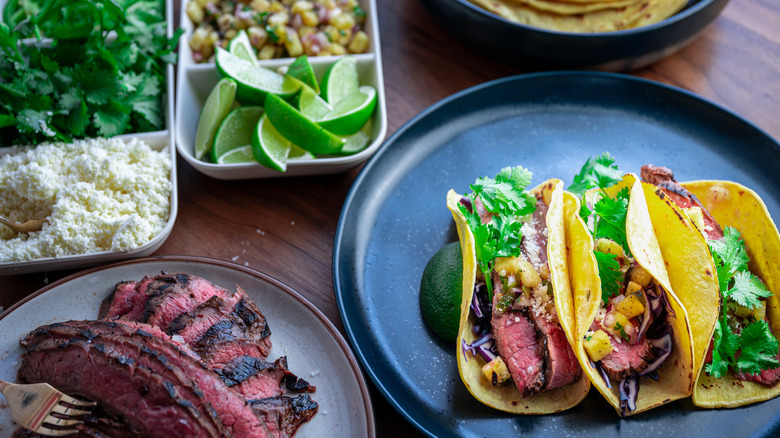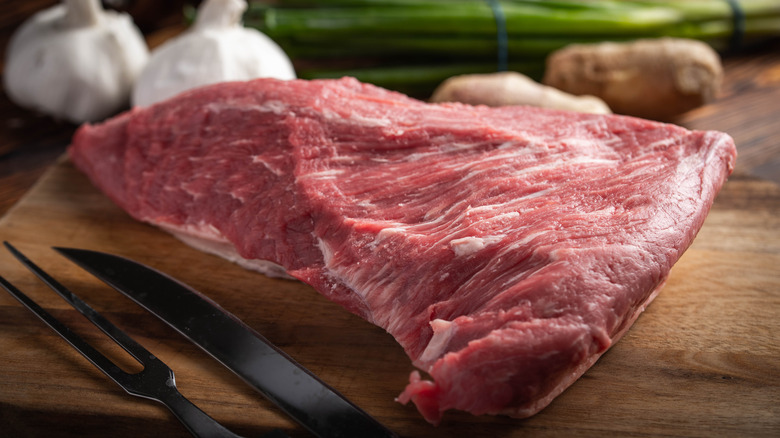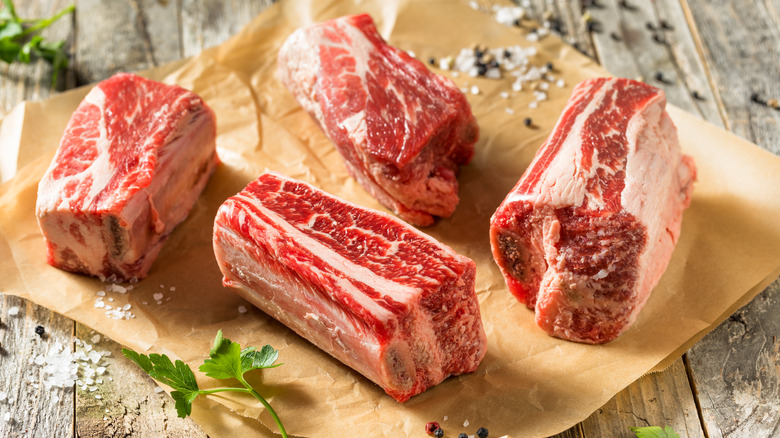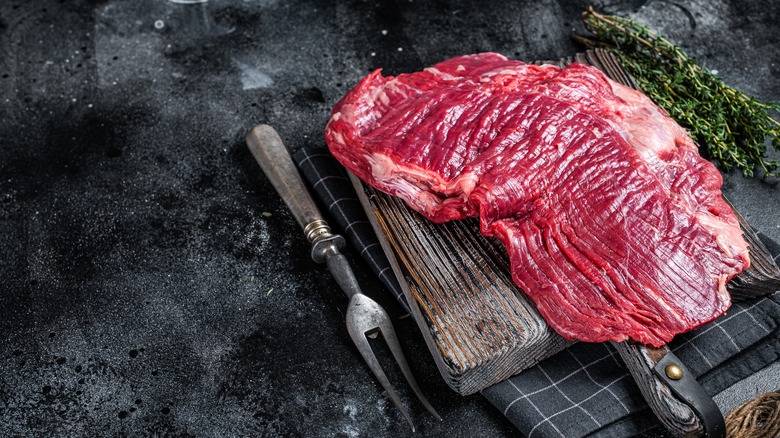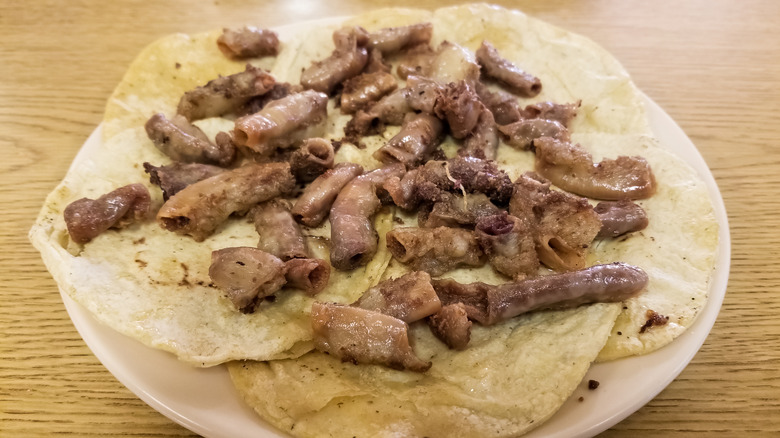12 Best Cuts Of Beef To Use When Making Tacos
Taco Tuesday. It's practically become a national holiday, with Mexican restaurants all over the US offering deals on the second night of the week. We've even started making them at home on the designated day. But why relegate the delectable dish to one night a week? Who says you can't enjoy a taco on a Monday or Thursday? Certainly not us. We'll eat those little meat-filled tortillas for any meal, any day or night of the week.
While there are many different types of tacos out there, one of our favorites is beef tacos, especially when the beef has a nice char on the outside and is pink and tender in the middle. We love chicken and fish tacos as well, but there's just something about the luscious red meat that gets us excited every time we think about it. If you're in the same boat, then you have the same problem we do: What cut of beef will make the best taco? You can put all the toppings you want on it, from the perfect queso fresco to a nice homemade guacamole. But if you don't have the right cut cooked to perfection, it doesn't matter what else is in that corn tortilla; it just won't be as good. So, we asked a few butchers and chefs what their go-to cuts are for the perfect beef taco, and they were nice enough to give us several.
Chuck
Jered Standing, owner of Los Angeles' Standing's Butchery, tells us there are "three 'styles' of beef taco: Shredded beef, chopped or sliced, and ground." Chuck is great for the shredded beef taco because it's best when it's cooked low and slow thanks to the large amount of collagen inside. The butcher tells us that the collagen, which can be found in several different cuts of beef, "gelatinizes during the cooking process and gives us that juicy, fall-apart tenderness."
Known for its beefy flavor, this cut is part of the cow's shoulder region and is one of the most common cuts out there. In fact, not only will your butcher carry it, it will definitely be in the meat department of your favorite grocery store. While you could cover the whole shoulder in spices and drop it into your preferred stock in the slow cooker, Standing recommends "cutting it into 2-inch cubes and searing all sides before braising on low heat for four to five hours." But if you don't have that kind of time, Standing says a pressure cooker will work just as well and you won't lose any of that wonderful flavor this cut is known for.
Tri-Tip Steak
Another popular cut of steak, tri-tip can be found at most meat shops. Maddox Lynn of El Camino Tacos in Florida tells us that this cut has a lot of marbling, which gives the meat that full, beefy flavor it's known for and why it's such a great choice for tacos. This steak falls into the sliced category that Standing mentioned because of all the fat weaving through it. Cut from the bottom sirloin part of the cow, it's a smaller, inexpensive piece of meat, but it's that marbling that makes this steak the note-worthy choice it is. Not only does it give the steak its rich flavor, but it also creates two distinct grains, which is why slicing the tri-tip can be tricky. Never carve the tri-tip steak with the grain. Instead, slice it against the grain for some seriously tasty tacos.
Slicing this steak is one option for a delicious taco, but it's not the only option. While you could grill or sear it and then slice, Lynn says you could slow cook it as well. "I do think its slightly tougher texture would make a fantastic protein for a barbacoa recipe," he explains. "The slower cook would lead to a succulently tender beef taco!"
Flat Iron Steak
Another cut from the shoulder region of the cow, the flat iron steak is considered to be one of the most tender cuts available. It's only second to the filet mignon. But because of its location and the fact that it's a newer cut, it's not nearly as expensive as the filet. But a pricier piece of meat doesn't always mean it's the best choice. In fact, this cheaper cut has tons of flavor thanks to the decent amount of marbling found within it. But even with all that marbling, it's still one of the leaner cuts out there. It also happens to be one of Standing's top choices for tacos, where the meat is sliced or chopped. "This one is kind of a more baller taco move," Standing explains.
Even though you can cook this steak in a variety of ways, Standing tells us that grilling it whole is the best way to prepare it for tacos. "Flat Iron is the second most tender on the animal, so you can grill it whole, then slice it without any difficulty later when it's time to eat. What I mean is, you can easily bite through the slices without half the contents of the taco sliding out with each bite," he clarifies.
Skirt Steak
There are two kinds of skirt steak: the inside and outside skirt. A thinner cut from the cow's plate section, the skirt steak tends to be a fattier cut of beef. As we've said time and time again, fat equals flavor, which means either of these cuts would be a great way to fill your tortillas. But we're not the only ones who think so. "This is the classic 'Carne Asada' style taco meat for good reason," explains Standing. It's "very easy, quick, and flavorful. You don't have to marinate it first, but I would recommend that."
Marinating the steak not only adds flavor to the meat, it tenderizes it as well because the acid usually included in marinades breaks down the steak's fibers. But as with all marinades, you want to be careful how long you let it soak. Since skirt steak is a significantly thinner cut than a ribeye or New York strip, you don't want to marinate it for any longer than 30 minutes or the meat will lose its structure and become mushy. It's for that reason that as soon as the meat comes out of the marinade, Standing recommends grilling or broiling it. "Then chop it to bits."
Short Ribs
If you have a busy day planned but really want tacos for dinner, then short ribs would be the way to go. No, unfortunately, short ribs won't be ready to eat in under 30 minutes. They'll take at least four hours to turn into a delicious meal. So, how does a cut of beef that takes hours to cook, translate into dinner on a day when you don't have time? Easy: use the slow cooker.
Most commonly found behind the cow's shoulders or in the plate section, short ribs are shorter pieces of rib bone that are covered in beef. But because they come from the chuck section of the cow, they have a lot of fat and tend to be a tougher cut of meat. Tough, marbled cuts are perfect for the slow cooker because a low and slow cook means the finished product will be a tender, succulent piece of meat that falls apart and is full of flavor. In other words, it's the perfect choice when you're in the mood for shredded tacos. But don't take our word for it; they've been eating short-rib tacos in Mexico forever. If you cook those ribs in your favorite chili powder and Mexican beer, you'll have a top-notch Taco Tuesday.
Flank Steak
"My current favorite cut of beef to work with is flank steak," says Lynn. It also happens to be one of the standard steaks used if you're making carne asada. A more accessible cut of beef, this universal steak comes from the flank of the cow and can be enjoyed all on its own or turned into fajitas. Lynn prefers this cut because of its "fantastic marbling," flavor, and price. But it's really the size and shape of this steak that make it the ideal choice for steak tacos. "Being a thin yet long and wide cut always yields a fantastic sear all over the entire cut. The consistent grain of the meat also aids in long consistent knife strokes when slicing for service, which in turn leads to neat and consistent shaped steak bites."
Lynn marinates his "flank for 24 hours in a fresh citrus marinade that includes fresh oranges, limes, garlic, jalapeños, serranos, and Adobo peppers. The acidity in this does a fantastic job breaking down some of the tougher bits and turns out tender and juicy tacos."
Hanger Steak
Similar to skirt steak, the hanger steak also comes from the belly of the cow. But where the skirt steak is a longer, thinner piece of meat, the hanger is significantly shorter and thicker. It also has a lot more fat marbling through it, making it an even more tender and flavorful cut. If this steak doesn't sound familiar, that's because it only recently became available to the average shop-goer. See, this used to be the cut the butcher would keep for himself, hence its original moniker: the butcher's cut. And we can understand why: Not only is the hanger steak a great, tender piece of meat full of luscious beefy flavor, but it tends to be more affordable than some of the other steaks with similar qualities.
Just like skirt steak and tri-tip, the best way to prepare this steak is by marinating it for an hour or so and then giving it a quick sear on the grill. That way, you're guaranteed a tender steak with plenty of flavor for tacos any night of the week.
Top Sirloin
A cut you've definitely heard of and maybe even enjoyed as a steak or kabobs is the top sirloin. This cut is known for its rich flavor and infinite tenderness, which is why it's one of the more popular cuts out there. But unlike several other cuts, which are rich and intensely tender, the top sirloin happens to be one of the leaner meats available. That's right, there's not a lot of fat hidden inside this cut. But the lack of fat doesn't equal a lack of flavor. These are just a few of the reasons why Jose Morales, the owner of the Tacos La Carreta taco truck in Long Beach, says this cut is his "favorite."
Morales only uses top sirloin on the truck "because it perfectly juices up with the charcoal grill." He tells us that the top sirloin itself is soft, juicy, and "does not dry up" when it's cooked. While some places might add several different herbs and spices for the perfect steak taco, Morales says that Tacos La Carreta only uses salt. The steak doesn't need anything else because when it's grilled to a perfect 135 degrees F, you have one hell of a tasty taco.
Beef Head and Cheeks
Now that we've covered some of the more common cuts of beef, there are a few less common options that may be difficult to find but are no less satisfying. One cut is the cow's head and cheeks. While cow's head, or cabeza, and beef cheeks may sound like an unusual taco filling here in the States, it's quite common down in Mexico. There, it's cooked for hours until all the meat falls off the skull. Then, different parts, including the eyes, cheeks, and even the brains, are shredded and turned into succulent meals.
If you're still unsure about ingesting this part of the cow, let us assuage those fears: This cut is actually pretty healthy for you. Not only is it extremely tender, but it's also one of the leanest cuts on the animal. But in order to achieve that tenderness, you need a proper cook, which means roasting or smoking it at a low temperature for several hours. This cut needs extra time because it's one of the toughest pieces of meat. "Cows chew and chew all day long," Standing explains, "so this is a VERY hard-working muscle." While cooking this cut takes planning and preparation, Standing promises "it's well worth it." He even tells us how to cook it: "A low, slow braise in chicken stock is my move here. For six to eight hours."
Tripa
There are a lot of different proteins that you could use to fill your taco. While flank, skirt, and hanger steaks are common options here in the States, some of the more uncommon organs of the cow work just as well and are pretty darned tasty. One such organ is tripa or cow's intestines. It is also popular in Mexico, where it's been enjoyed for years.
So, what does it taste like? First, cooking tripas is a bit more involved than your standard steak, though, as it takes a few steps to go from raw intestine to sumptuous taco. We know it may not look very appetizing, but if it's prepared correctly, the final result culminates in a piece of meat that's crispy on the outside and soft and chewy on the inside, with a savory meatiness that doesn't taste like anything else. But cooking is key, which means boiling the tripa for a significant amount of time. The intestines must be boiled because, like so many of the cuts we've mentioned, they're another hard-working muscle that equals a tougher piece of meat. But an extensive amount of time in boiling water or stock will guarantee a tender protein that melts in your mouth.
Tongue
Here in the States, we tend to fill our tacos with meat from the cow's shoulder, plate, and loin. But in Mexico, they like to eat every single part of the cow, including some unusual muscles like the stomach, intestines, and even the tongue. While it may not be the most appetizing-looking piece of meat, don't be so quick to discount this tasty tidbit. Not only is the tongue frequently used as the base for many a taco and burrito once roasted and sliced, but it's also a common choice for deli sandwiches all over America. So, even though you may not be able to find tongue at your local grocery store if you're up for an edible adventure, we guarantee you'll find it on display in many a butcher shop. Even Standing's Butchery carries it.
"This is my favorite one lately," Standing exclaims. "It's very easy to cook and so flavorful. Just boil it for four to five hours in salty water with garlic, peppers, and onions," the butcher continues. "This scary-looking skin just peels right off, and the meat inside will fall apart."
Suadero
If you're wondering what suadero is, don't worry, you're not alone. A common delicacy south of the border, it's practically unheard of here in America. Unfortunately, uncommon usually means it won't be easy to find. Most butchers just don't carry it, and you almost definitely won't find it at the grocery store. But just because it will take some work to find this delectable cut of beef doesn't mean you should dismiss it. In fact, we'd recommend going the extra mile for it because the final product will definitely be worth your time.
Cut from the middle of the cow between the sirloin and flank, suadero has a smooth texture and a nice, rich, beefy flavor, but only if it's prepared correctly. Simply roasting or grilling this cut will garner a bland and chewy piece of meat. But if you braise the meat for a few hours in lard or hearty beef stock, you'll achieve the richness one looks for in a satisfying suadero taco.
